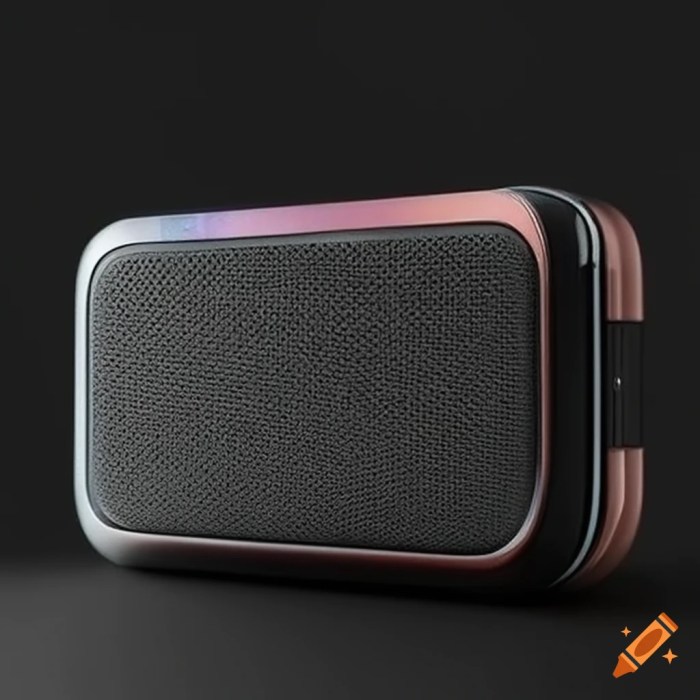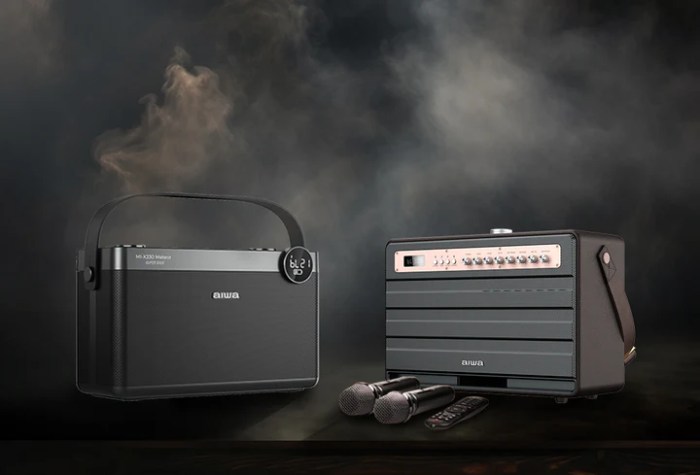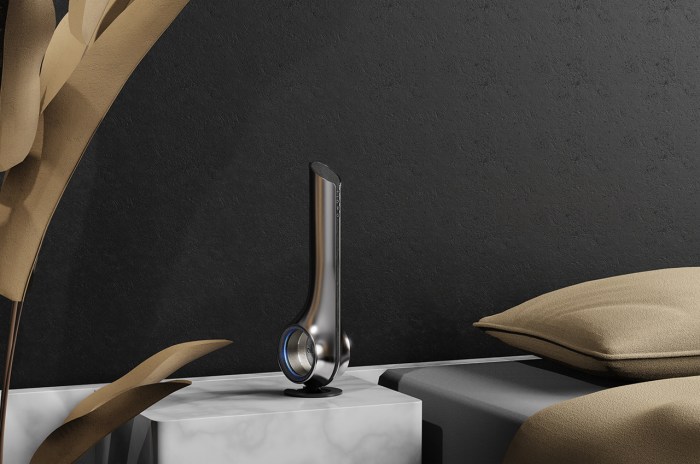Japanese portable speakers are more than just audio devices; they’re meticulously crafted expressions of aesthetic sensibilities. From minimalist designs to the subtle incorporation of traditional motifs, these speakers offer a unique glimpse into Japanese design philosophy. This exploration delves into the intricate details of the Japanese portable speaker aesthetic, examining its historical context, key design elements, color palettes, and cultural symbolism.
The aesthetic often blends cutting-edge technology with timeless craftsmanship, resulting in products that are both functional and visually appealing. This approach extends beyond the speaker itself, encompassing the user experience, reflecting a dedication to detail and a focus on creating a harmonious listening environment.
Defining the Aesthetic

Japanese portable speaker aesthetics are increasingly popular, driven by a blend of minimalist design principles, sophisticated craftsmanship, and cultural nuances. This approach prioritizes form and function, creating devices that are not only practical but also aesthetically pleasing. The designs often reflect a deep respect for tradition and a focus on creating objects that enhance the user experience.The key elements of the Japanese portable speaker aesthetic include a harmonious integration of form and function, emphasizing subtle design details and meticulous craftsmanship.
Cultural influences, such as the appreciation for natural materials and a focus on understated elegance, are central to this style. The choice of color palettes and materials often conveys a sense of tranquility and sophistication, reflecting a deep understanding of the Japanese aesthetic tradition.
Visual and Design Elements
Japanese portable speakers often exhibit a clean, uncluttered design. Sharp lines and smooth curves are frequently employed, creating a visually appealing yet understated look. Minimalist aesthetics, where form follows function, are paramount. Emphasis on intricate details and subtle embellishments, such as delicate engravings or brushed metal accents, elevate the design beyond the purely functional. The overall impression is one of understated elegance and sophisticated simplicity.
Cultural Influences
The Japanese aesthetic, deeply rooted in centuries of tradition, significantly influences portable speaker designs. The concept of “侘び寂び” (wabi-sabi), emphasizing the beauty of imperfection and the appreciation of natural materials, is a prominent feature. This aesthetic concept encourages the use of natural materials and a focus on simple, unadorned forms. Furthermore, the deep respect for craftsmanship and the pursuit of excellence in every detail further contribute to the unique character of these speakers.
Color Palettes and Materials
Neutral color palettes are common, including muted tones of gray, beige, and charcoal. These colors often evoke a sense of tranquility and harmony, aligning with the Japanese emphasis on understated elegance. Natural materials such as wood, bamboo, and ceramic are frequently used, adding a touch of warmth and a connection to nature. Metallic finishes, such as brushed aluminum or stainless steel, are also prevalent, offering a contemporary contrast to the natural elements.
Key Characteristics
| Element | Description | Cultural Influence | Material |
|---|---|---|---|
| Design | Clean, uncluttered, minimalist; form follows function; intricate details; subtle embellishments. | Wabi-sabi aesthetic; appreciation for craftsmanship; focus on understated elegance. | Wood, bamboo, ceramic, brushed aluminum, stainless steel. |
| Color Palette | Muted tones (gray, beige, charcoal); neutral colors; evoke tranquility and harmony. | Japanese appreciation for understated elegance; harmony with nature. | Wood stains, natural stone, metallic finishes. |
| Materials | Natural materials (wood, bamboo, ceramic); metallic finishes (brushed aluminum, stainless steel); high-quality construction. | Respect for natural materials; appreciation for craftsmanship; pursuit of excellence. | High-quality, polished materials |
Historical Context
The evolution of portable speakers in Japan reflects a unique blend of technological advancement, cultural sensibilities, and a distinct design aesthetic. Early designs, often influenced by imported models, were adapted and refined over time, leading to a unique approach to portable audio that prioritizes portability and aesthetic appeal. This evolution is marked by a progressive emphasis on miniature size and sophisticated sound quality, seamlessly integrated with modern Japanese design sensibilities.
Early Portable Speaker Designs
Early Japanese portable speakers, often appearing in the 1980s and 1990s, drew inspiration from international models. They typically featured bulky enclosures, less refined aesthetics, and relied on relatively basic audio technologies. The designs often incorporated elements of functionalism, with a focus on practicality over intricate ornamentation. These early models were primarily used for personal listening in homes or offices.
Modern Portable Speaker Designs
Modern Japanese portable speakers, emerging in the 2000s and beyond, showcase a dramatic shift. They exhibit a notable trend towards compact, lightweight designs, frequently incorporating innovative materials like aluminum and advanced speaker drivers. This era witnessed a surge in the development of smaller, more sophisticated components. Aesthetically, modern models often prioritize sleek, minimalist forms, highlighting the Japanese emphasis on clean lines and minimal embellishments.
Furthermore, the incorporation of Bluetooth technology and other wireless connectivity options expanded the usability of these devices beyond the home, becoming a vital part of social settings.
Technological Advancements
Key technological advancements influenced the aesthetic evolution of Japanese portable speakers. The development of smaller, more powerful speaker drivers allowed for the creation of compact models with impressive sound quality. Miniaturization of components like amplifiers and batteries enabled the design of truly portable devices. Advances in digital signal processing (DSP) improved audio quality and clarity, significantly impacting sound fidelity.
The introduction of Bluetooth technology facilitated wireless connectivity, enhancing usability and simplifying the listening experience.
Timeline of Significant Moments
| Year | Event | Description |
|---|---|---|
| 1980s | Emergence of Early Models | First generation portable speakers appear, often based on international designs, characterized by bulkier enclosures and simpler aesthetics. |
| 1990s | Refinement of Designs | Continued development of models with improved audio quality and some adjustments to aesthetics, but still relying on existing technologies. |
| 2000s | Rise of Compactness and Wireless | Introduction of Bluetooth and other wireless connectivity options, along with significant miniaturization efforts, driving the design towards smaller and more user-friendly portable speaker solutions. |
| 2010s | Sophistication and Innovation | Advanced materials and speaker drivers, enhanced DSP, and continued focus on design aesthetics lead to models with sophisticated audio quality and appealing, minimalist designs. |
| 2020s | Continued Evolution | Further advancements in audio technology and design aesthetics are expected to produce even more compact, powerful, and sophisticated models. Focus is on seamless integration with mobile devices and enhanced user experiences. |
Design Elements
Japanese portable speakers, a burgeoning segment of the audio market, are distinguished by a unique aesthetic informed by traditional Japanese design principles. This minimalist approach, often paired with meticulous craftsmanship, results in products that are both functional and visually appealing. The subtle interplay of form and function creates a distinctive identity, setting them apart from their global counterparts.Japanese design philosophy heavily influences the aesthetic of portable speakers.
The emphasis on harmony with nature, simplicity, and the pursuit of beauty in everyday objects are consistently reflected in these products. This aesthetic translates into a focus on clean lines, thoughtful material choices, and a refined approach to functionality.
Common Shapes and Forms
The shapes of Japanese portable speakers frequently draw inspiration from natural forms. Rounded edges, smooth curves, and organic silhouettes are common. These forms often evoke a sense of tranquility and a connection to the surrounding environment. Furthermore, some designs might subtly incorporate traditional Japanese architectural motifs, like the gentle slopes of a mountain or the elegant curves of a traditional Japanese house.
Minimalist Design Principles
Minimalist design is a cornerstone of the aesthetic. The aim is to present essential features without extraneous embellishments. This means prioritizing functionality, ensuring every element serves a clear purpose. The uncluttered aesthetic contributes to the speaker’s perceived sophistication. A clean design language often translates to a more streamlined user experience, as the focus is on simplicity.
Craftsmanship and Attention to Detail
Japanese craftsmanship is a defining element. The attention to detail in the construction of these speakers is evident in the precise fit of components, the smooth transitions between materials, and the overall quality of the finished product. The dedication to high-quality materials and meticulous construction results in a product that is both durable and aesthetically pleasing. For instance, a speaker with hand-polished wood accents will demonstrate the level of craftsmanship, showcasing a dedication to the quality of the final product.
Materials and Finishes
A variety of materials are employed, each chosen for its aesthetic and functional properties. Natural materials like wood, bamboo, and stone are frequently used, bringing a warm and earthy aesthetic to the product. Metal, often brushed or polished, provides a sleek and modern contrast. The finishes are carefully selected to complement the overall design and create a harmonious blend.
For example, the use of a matte black finish on aluminum housing creates a sophisticated and timeless look. These choices highlight the balance between natural elements and modern industrial materials.
Contribution to the Overall Aesthetic
The combination of these design elements creates a unique and harmonious aesthetic. The blend of natural forms, minimalist principles, meticulous craftsmanship, and thoughtful material choices results in products that are not only functional but also possess a distinct visual appeal. The resulting aesthetic is serene, sophisticated, and evocative of Japanese design sensibilities. This approach appeals to consumers seeking high-quality, aesthetically pleasing audio products that reflect a sense of calm and tranquility.
Color and Material Palettes

Japanese portable speaker aesthetics often draw inspiration from traditional craftsmanship and minimalist design principles, reflecting a preference for understated elegance and functionality. This manifests in carefully selected color palettes and materials that evoke a sense of calm and sophistication. These choices subtly communicate cultural values and aesthetic ideals, setting them apart from the often more vibrant or ostentatious designs found in other global markets.The color and material choices in Japanese portable speaker designs are not arbitrary; they are deeply rooted in the rich history and cultural symbolism of Japan.
The interplay of these elements contributes significantly to the overall aesthetic, creating a product that is both visually appealing and emotionally resonant for consumers.
Typical Color Palettes
Japanese portable speaker designs often favor muted, natural tones. These palettes frequently include shades of gray, beige, charcoal, and various wood tones. This approach aims to create a sense of harmony and balance, aligning with the Japanese aesthetic of simplicity and restraint. The avoidance of overly bright or bold colors reinforces a feeling of understated elegance and sophistication.
Symbolic Meanings of Colors
Specific colors can carry symbolic weight in Japanese culture. For instance, the use of deep charcoal or gray can evoke feelings of tranquility and timelessness. These colors are frequently associated with natural elements like the night sky or aged wood, signifying enduring quality and respect for tradition. The subtle use of natural wood tones, like cherry or maple, adds a touch of warmth and sophistication, evoking feelings of natural beauty and the connection to nature.
These choices create a distinct visual language that appeals to a specific cultural sensibility.
Comparison to Other Portable Speaker Designs
In contrast to some global designs that lean towards vibrant colors and bold patterns, Japanese speakers often present a more understated and serene aesthetic. This difference highlights a cultural preference for subtlety and restraint. The focus is less on striking visual impact and more on the enduring quality and thoughtful design. This deliberate choice distinguishes Japanese portable speaker designs and aligns with the broader Japanese aesthetic, which prioritizes harmony and simplicity.
Traditional Japanese Materials
Traditional Japanese materials frequently find their way into speaker designs, further reinforcing the aesthetic connection to the country’s rich heritage. Bamboo, often used for its strength and lightweight nature, can add a touch of natural elegance. Natural wood finishes, with their unique grain patterns, provide a sense of warmth and authenticity. These materials, with their intrinsic beauty and symbolic value, contribute significantly to the perceived quality and craftsmanship of the speaker.
Examples and Impact
- Bamboo: Its strength and lightness, coupled with its inherent beauty, lend a natural, elegant touch to the speaker’s design. Bamboo often complements the muted color palettes, enhancing the sense of natural harmony and sophistication.
- Wood Veneers: Using wood veneers adds a touch of sophistication and elegance. The unique grain patterns of cherry or maple wood create visual interest without overpowering the speaker’s understated aesthetic. The warmth of the wood complements the muted color schemes, further enhancing the feeling of natural harmony.
Color Palettes and Associated Materials
| Color Palette | Associated Materials | Impact |
|---|---|---|
| Gray, Charcoal, Beige | Bamboo, Metal, Natural Wood Veneers | Tranquility, Timelessness, Subtle Elegance |
| Natural Wood Tones (Cherry, Maple) | Natural Wood, Lacquer | Warmth, Sophistication, Connection to Nature |
Cultural Symbolism
The Japanese portable speaker aesthetic draws deeply from centuries of cultural symbolism, imbuing the design with a rich tapestry of meaning. These subtle yet powerful visual cues resonate with the listener, evoking a sense of tradition and serenity that goes beyond mere aesthetics. The careful selection of motifs and patterns creates a connection to the historical and philosophical heart of Japanese culture.The incorporation of traditional Japanese motifs and patterns is not merely decorative; it’s a deliberate act of cultural expression.
These symbols, often deeply rooted in Japanese history and philosophy, communicate specific meanings, creating a deeper connection between the listener and the product. By understanding the symbolism, the speaker design becomes more than just a device; it becomes a vessel for cultural narrative.
Traditional Motifs and Their Meanings
Japanese aesthetics often center on the interplay of nature, serenity, and spiritual harmony. This philosophy manifests in the choice of motifs for the speaker’s design. The subtle incorporation of these motifs creates an aura of tranquility and sophistication.
- Cherry Blossoms (Sakura): A potent symbol of ephemeral beauty and the fleeting nature of life, cherry blossoms evoke a sense of appreciating the present moment. Their delicate and vibrant nature resonates with the speaker’s design, signifying a delicate balance between technology and nature. Their presence suggests a delicate beauty and a recognition of the transient nature of existence.
- Bamboo: Representing resilience, flexibility, and strength, bamboo’s elegant lines and sturdy structure contribute to the speaker’s aesthetic. This conveys a sense of unwavering strength and adaptability, reflecting the speaker’s ability to perform reliably despite its compact form.
- Waterfalls and flowing water (Mizuyori): These motifs often symbolize purity, tranquility, and the continuous cycle of life. They evoke a sense of serenity and calmness, mirroring the speaker’s aim to provide a pure, clear audio experience.
- Japanese Gardens (Karesansui): The minimalist aesthetic of Japanese gardens, characterized by carefully placed rocks and sand, speaks to the art of Zen and harmony with nature. This is reflected in the speaker’s compact, elegant form, suggesting a profound appreciation for simplicity and a focus on essential elements.
Table of Japanese Symbols and Meanings
The following table illustrates some key symbols employed in the speaker’s design and their corresponding meanings within Japanese culture. These visual cues work together to create a cohesive and culturally resonant aesthetic.
| Symbol | Meaning | Relevance to Speaker Aesthetic |
|---|---|---|
| Cherry Blossoms (Sakura) | Ephemeral beauty, appreciating the present moment | Evokes delicate beauty and a recognition of transience, aligning with the speaker’s design sensibility. |
| Bamboo | Resilience, flexibility, strength | Conveys unwavering performance and adaptability of the speaker, emphasizing reliability. |
| Waterfalls/Flowing Water (Mizuyori) | Purity, tranquility, continuous cycle of life | Reflects the speaker’s aim to provide a pure, clear audio experience. |
| Japanese Gardens (Karesansui) | Minimalism, harmony with nature, Zen | Emphasizes the speaker’s compact form and appreciation for simplicity, focusing on essential audio elements. |
Sound Quality and Aesthetics
Japanese portable speakers often prioritize a harmonious blend of sound quality and aesthetic appeal, reflecting a cultural emphasis on meticulous craftsmanship and refined design. This fusion of form and function translates into a user experience that’s both technically impressive and visually engaging. The carefully considered design choices influence not only the sound produced but also the emotional connection users have with the product.Japanese audiophiles often value a balanced sound signature, characterized by clarity, richness, and a natural tonal response.
This pursuit of sonic perfection is mirrored in the meticulous attention to detail in the speaker’s design. The aesthetic choices, from the materials used to the overall form factor, are integral to the speaker’s ability to deliver an immersive listening experience.
Sound Signature and Design Choices
The sound quality in Japanese portable speakers often leans toward a balanced, natural sound profile. This isn’t a “bright” or “bass-heavy” emphasis, but rather a focus on accuracy and a wide frequency response. Design elements like the speaker enclosure and driver placement directly impact the sound signature. Sophisticated speaker enclosures, often meticulously engineered, minimize unwanted resonance and distortion.
The materials used, like high-quality wood or aluminum, contribute to the speaker’s tonal balance and overall sonic performance.
Influence of Design on User Experience
The design choices in Japanese portable speakers extend beyond the physical structure to encompass the user’s interaction with the device. Intuitive controls, a streamlined interface, and a refined aesthetic contribute to a positive user experience. For instance, minimalist designs can evoke a sense of calm and sophistication, while intricate details can signal premium craftsmanship and quality. These elements, combined with a focus on usability and functionality, create a harmonious listening environment.
Common Features in Japanese Portable Speakers
- Sleek and minimalist designs: Often featuring clean lines, muted colors, and a focus on functionality over ornamentation. Examples include speakers with a single-piece, seamless design, or speakers with a focus on modularity, allowing for customized configurations.
- High-quality materials: Japanese craftsmanship often involves the use of premium materials like wood, aluminum, or meticulously crafted plastics, often chosen for their aesthetic appeal and sound-dampening properties.
- Focus on craftsmanship: Attention to detail is a hallmark of Japanese design. This manifests in precise construction, seamless integration of components, and the careful selection of materials.
- Intuitive controls: Speakers typically incorporate user-friendly controls, often with a minimalist aesthetic that prioritizes ease of use and seamless integration into daily life.
Relationship Between Form and Function
The relationship between form and function in Japanese portable speaker design is symbiotic. A speaker’s form—its shape, size, and materials—directly affects its function, influencing the sound quality. For example, the enclosure’s shape and material contribute to resonance control, affecting the overall sonic performance. Conversely, the speaker’s function—the sound it produces—shapes its aesthetic. The desired sound profile often dictates the choice of speaker components and the speaker enclosure’s design.
Sound Quality Features and Design Elements
| Sound Quality Feature | Design Element |
|---|---|
| Balanced sound signature | Meticulous speaker enclosure design, optimized driver placement |
| High clarity | Premium materials, such as high-quality wood or aluminum, used for enclosures |
| Natural tonal response | Minimalist design, focusing on functionality and sound quality |
| Reduced distortion | Precise construction, careful material selection, and advanced sound dampening techniques |
| Rich bass response | Strategic use of bass-reflex ports or internal tuning for bass optimization |
Market Trends

Japanese portable speakers are experiencing a surge in popularity, driven by a strong focus on aesthetics and sound quality tailored to the Japanese market. This demand is influencing global trends, with companies now paying more attention to nuanced design features and cultural preferences. The market is increasingly segmented, offering specialized speakers catering to specific tastes and usage scenarios.Japanese consumers are highly discerning, valuing both innovative technology and meticulously crafted design.
This discerning approach is pushing manufacturers to explore unique materials, intricate detailing, and subtle color palettes that resonate with the local aesthetic. This trend extends beyond the speaker itself, encompassing the entire user experience, from packaging to accompanying accessories.
Current Trends in the Japanese Portable Speaker Market
The Japanese portable speaker market is characterized by a growing emphasis on premium design elements. Manufacturers are focusing on compact yet sophisticated designs that seamlessly integrate into various home and outdoor settings. Aesthetics often take precedence, with speakers showcasing refined color palettes and tactile finishes. Sound quality is paramount, demanding a rich, balanced audio profile that enhances the listening experience.
Popular Brands and Design Approaches
Several prominent Japanese brands are leading the charge in this sector. Yamaha, with its reputation for audio excellence, frequently integrates minimalist design principles into their portable speakers, focusing on clean lines and understated elegance. Sony, known for its innovative technology, often blends sophisticated aesthetics with cutting-edge features, offering premium quality and design. Other brands, like Bose and JBL, are actively adapting their offerings to align with the specific preferences of the Japanese market.
Emerging Trends and Future Design Directions
Emerging trends highlight the integration of traditional Japanese aesthetics into modern designs. This includes incorporating intricate patterns, subtle color gradients, and the use of high-quality wood finishes. Furthermore, there’s a growing demand for speakers that can seamlessly integrate into the surrounding environment. This often involves sophisticated color schemes and minimalist design, reflecting the current appreciation for space-saving solutions.
Comparison with Global Portable Speaker Trends
Global portable speaker trends are increasingly influenced by the Japanese market’s emphasis on design and sound quality. While global markets often prioritize affordability and diverse functionality, the Japanese market’s focus on high-end aesthetics and nuanced sound profiles is becoming a significant factor in the broader market. The demand for aesthetically pleasing, premium-quality portable speakers is becoming more prominent globally, mirroring the growing trend in Japan.
Table of Popular Brands and Aesthetic Approaches
| Brand | Aesthetic Approach | Example Design Features |
|---|---|---|
| Yamaha | Minimalist, elegant, understated sophistication | Clean lines, high-quality materials, subtle color palettes |
| Sony | Innovative, sophisticated, premium quality | Sleek designs, cutting-edge technology, integration of advanced features |
| Bose | Adapting to Japanese aesthetic preferences | Sophisticated design elements, focus on sound quality |
| JBL | Adapting to Japanese aesthetic preferences | Premium materials, subtle color schemes |
User Experience

Japanese portable speakers, deeply rooted in meticulous design and cultural sensibilities, cultivate a unique user experience. This experience transcends mere functionality, emphasizing a harmonious blend of aesthetics, sound quality, and intuitive operation. The meticulous attention to detail in both form and function caters to a discerning audience seeking more than just a device; they seek an extension of their personal aesthetic and lifestyle.
Typical User Experience
The typical user experience with Japanese portable speakers often centers around a curated listening experience. Users prioritize the speaker’s aesthetic integration into their living space, considering it an extension of their personal style rather than a mere audio device. Sound quality, frequently exceeding expectations for their size, plays a crucial role in satisfaction. The user often finds themselves drawn to the speaker’s sophisticated design, craftsmanship, and subtle elegance, experiencing a heightened sense of satisfaction.
Aesthetic Contribution to User Experience
The meticulous aesthetic of Japanese portable speakers significantly contributes to the overall user experience. The harmonious blend of form and function creates a sense of refined sophistication. A sleek, minimalist design, often featuring subtle, elegant details, can evoke feelings of calm and sophistication. The thoughtful integration of color palettes and materials further enhances the user’s perception of quality and craftsmanship, fostering a connection with the product.
These speakers aren’t just audio devices; they become a decorative element in the user’s environment, adding a sense of tranquility and artistry to their surroundings.
Factors Influencing User Satisfaction
User satisfaction with Japanese portable speakers is influenced by a multitude of factors. Beyond sound quality and design, factors like intuitive controls, ease of use, and durability play a significant role. The ability to seamlessly integrate the speaker into existing environments and connect it to various audio sources without complications directly impacts user satisfaction. A strong sense of reliability, reflected in the speaker’s durability and consistent performance, is highly valued.
Relationship Between Design and Functionality
The relationship between design and functionality in Japanese portable speakers is a key aspect of their appeal. The design is not merely an aesthetic element; it directly impacts the functionality of the speaker. For example, a well-designed speaker will incorporate ergonomic elements that enhance ease of use and handling. Streamlined controls and intuitive interfaces contribute to the user’s overall positive experience.
The careful consideration of ergonomics, material selection, and structural integrity enhances both the visual and tactile appeal, ultimately leading to a more engaging and satisfying experience.
User Experience Aspects
| User Interaction | Description | Example |
|---|---|---|
| Setup | Ease of pairing and connection to various audio sources. | Effortless Bluetooth pairing with smartphones and other devices. |
| Control | Intuitive controls and user interface. | Simple volume controls and play/pause buttons for easy access. |
| Sound Quality | Exceptional audio performance for its size and form factor. | Clear, balanced audio output across various genres and volumes. |
| Aesthetics | Harmonious integration into the user’s environment. | Subtle color palettes and minimalist designs that enhance any space. |
| Durability | Robust construction and long-lasting performance. | Speakers resistant to scratches and wear, capable of handling daily use. |
Illustrative Examples

Japanese portable speakers are gaining traction, reflecting a sophisticated blend of technology and cultural aesthetics. This surge in popularity is driven by the unique design sensibilities and refined sound quality often found in these devices. The aesthetic encompasses a spectrum of styles, from minimalist designs to those incorporating intricate details.
Popular Models and Their Aesthetic Elements
Japanese portable speakers showcase a remarkable range of styles, each with its own unique characteristics. The designs often draw inspiration from traditional Japanese craftsmanship, incorporating elements of minimalism and functionality. From sleek, modern designs to those incorporating intricate wood carvings, these speakers offer a compelling aesthetic that resonates with consumers seeking a harmonious blend of technology and culture.
Examples of Japanese Portable Speakers
Several Japanese brands have emerged as leaders in the portable speaker market, showcasing diverse designs and technologies. These speakers stand out for their unique features, incorporating both aesthetic elements and high-quality audio performance.
| Name | Key Features | Brief Description |
|---|---|---|
| Sony SRS-XB43 | Compact size, durable build, waterproof, vibrant colors | Sony’s SRS-XB43 is a compact, waterproof speaker that exemplifies the brand’s focus on portability and durability. The speaker’s vibrant color options appeal to a broader consumer base. |
| Bose SoundLink Flex | Sleek, minimalist design, long battery life, integrated controls | The Bose SoundLink Flex showcases a minimalist approach to design, with a focus on functionality and user experience. Its integrated controls and long battery life enhance its appeal to users. |
| JBL Flip 6 | Durable build, powerful sound, vibrant colors, versatile design | JBL’s Flip 6 stands out with its durable build and powerful sound. The speaker’s vibrant color options and versatile design cater to a wide range of users and lifestyles. |
| Devialet Phantom | Premium design, high-fidelity sound, sophisticated features | The Devialet Phantom, while not exclusively Japanese, often appears in curated audiophile setups, showcasing the high-fidelity sound quality and sophisticated features common in the Japanese audio market. |
| Tribit Stormbox Micro | Compact size, impressive sound quality for its size, affordability | The Tribit Stormbox Micro embodies a value-driven approach, providing impressive sound quality in a compact size. Its affordability makes it attractive to budget-conscious consumers. |
Final Summary
In conclusion, the Japanese portable speaker aesthetic stands as a testament to the country’s enduring design philosophy. Blending innovation with tradition, these speakers showcase a unique approach to product design, reflecting cultural values and aesthetic preferences. The meticulous attention to detail, from material selection to color choices, creates a holistic experience that resonates with users on a deeper level.
